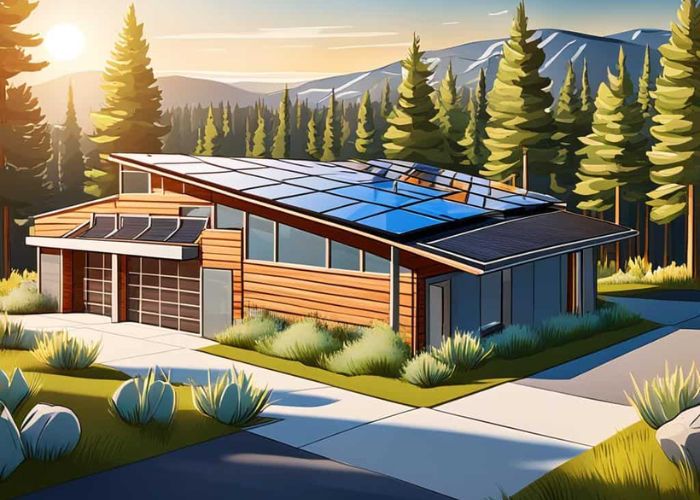I have been an energy sector analyst for the last seven years, and in that time I have seen amazing developments in power plant technology that promise cleaner, more efficient power in the future. In this essay, I will discuss a few of the new trends and advancements that are impacting the design of future power plants. Let’s read below about “Future Power Plants – New Tech and Efficiency Trends Worldwide”.
Transitioning to Renewables
A significant shift is occurring as renewable energy sources including solar, wind, and hydropower progressively supplant fossil fuels. By 2050, renewable energy might account for half of the world’s electricity, up from 25% in 2018. The demand for cheaper renewable energy sources and growing concerns about climate change are the forces behind this movement.
Many countries are moving away from coal and toward renewable energy sources, such as solar and wind. The United States added over 10 GW of solar capacity in 2018, while retiring over 15 GW of coal capacity. With the help of smart grid technology, demand response, and storage, the system is adjusting to accommodate intermittent resources more effectively; most of the capacity additions have come from renewable sources.
Nuclear Renaissance
A number of countries’ efforts to find zero-emission baseload power sources have occurred at the same time as a revival of nuclear power. After the Fukushima disaster in 2011, nuclear building froze all around the world. However, countries like China and the United Arab Emirates are seeing a proliferation of new manufacturing.
Several new companies are also developing safer, smaller, and cheaper designs for next-generation reactors. Small modular reactors, or SMRs, can be mass-produced and activated rapidly. I believe SMRs will gain popularity as their advantages are more widely recognized. The three countries leading SMR technology development at the moment are Canada, Russia, and China.
Natural Gas Growth
Additionally, the shale gas boom is one of the factors propelling the growth of natural gas power generation. Gas is an attractive alternative to nuclear power and coal as a bridging fuel due to its greater versatility and lower carbon dioxide emissions. The efficiency of modern combined-cycle gas turbine (CCGT) facilities can exceed 60%. Because gas is both abundant and cheap, gas-fired electricity is expected to gain market share in the next decades.
Improving Efficiency
Improving efficiency is the main goal of future plants. For example, GE just introduced a 62.2% efficient HA gas turbine that can produce over 500 MW. In addition, Siemens is now conducting tests on a 4000C steam turbine that might reach a 65% efficiency level. These enhancements make plants more eco-friendly and cost-effective.
Read More:- American Crystal Sugar Company – USA’s Top Biomass Power Plant
Waste heat recovery works wonders for efficiency as well. In order to recover waste heat, contemporary combined cycle systems often include thermochemical recuperators and storage. Hybrid solar-fossil power plants are also becoming more popular for using concentrated sun power to superheat steam. It is feasible that this hybridization might lead to an efficiency boost of around 70%.
Power plants that use coal to generate electricity are also improving their output. More than half of the efficiency gains seen by ultra-supercritical and advanced ultra-supercritical plants have been attained under pressures over 700°C and 350 bar. Fluidized bed combustion allows coal plants to drastically cut emissions. Integrating carbon capture technology can decrease CO2 emissions, but it impacts efficiency. When compared to their subcritical forebears, modern, more efficient coal power stations cut CO₂ emissions by a minimum of 25%.

Energy Storage Integration
Many believe that power systems will be drastically altered by advancements in storage technologies. Battery storage, compressed air, flywheels, hydrogen, and pumped hydro can all work together to balance grid services with variable renewables. Lithium-ion battery deployments on a utility scale have already begun, and pumped hydro accounts for over 90% of the world’s storage capacity.
Read More:- Hellisheiði Power Station – Iceland’s Important Geothermal Facility Updates A Vast Geothermal Resource
With the ongoing drop in storage prices, it is becoming more viable to integrate wind and solar farms into gigawatt-scale projects. Storage could possibly make VRE plants dispatchable. A 400 MWh Tesla battery and an Australian wind farm are two of the numerous ongoing pilot projects. Storage is going to be important for future networks to integrate additional renewable power sources.
Microgrids and Distributed Energy
The expansion of rooftop solar, electric vehicles, and batteries has led to a rise in the utilization of microgrids and distributed energy systems. Communities can make themselves more resistant to grid outages by adopting local power and storage. Rural towns, military posts, and university campuses are among the many places where microgrids are taking root. Their significance will grow as grids undergo further decentralization.
According to gevernova, Future power plants may be located closer to demand hubs in an effort to further reduce transmission losses. Distributed multi-MW gas turbines and solar systems are occupying this area. Some think that the grid will eventually become less centralized.
Digitalization and Intelligence
Also, digital technology is changing the way plants work. New applications for innovations like as drones, big data analytics, and artificial intelligence include performance optimization, safety monitoring, anomaly detection, predictive maintenance, and more. Transparency, efficiency, and reliability are all enhanced as a result.
It is possible to create a virtual replica of the physical plant that functions similarly to the original using digital twin technologies. The integration of digital twins with augmented and virtual reality enables the remote training of plant personnel. Power plants can now sell electricity and share resources through new blockchain networks. The future grid will have greater intelligence, automation, and resilience thanks to digitization.
Conclusion
Currently, there is a great deal of innovation occurring in the power industry, which makes being a part of it fascinating. According to my vast experience as a market researcher, the future is bright for digital technologies, improved nuclear power, renewable energy, gas power, and energy storage. Though they will continue to have an impact, fossil fuels will be superseded by a greener energy system in due time. It is safe to assume that power plants of the future will be far more advanced, efficient, and environmentally conscious than those of the past. I hope you like reading “Future Power Plants – New Tech and Efficiency Trends Worldwide”.

Mohsen Ali is a Chemical Engineer with over a decade of experience in the energy sector. Specializing in power plant efficiency and sustainability, he brings expert insights to borderpowerplants.org. Mohsen holds a Master’s degree in Chemical Engineering and is dedicated to advancing sustainable energy solutions. Connect with him on Instagram or LinkedIn for more insights.
